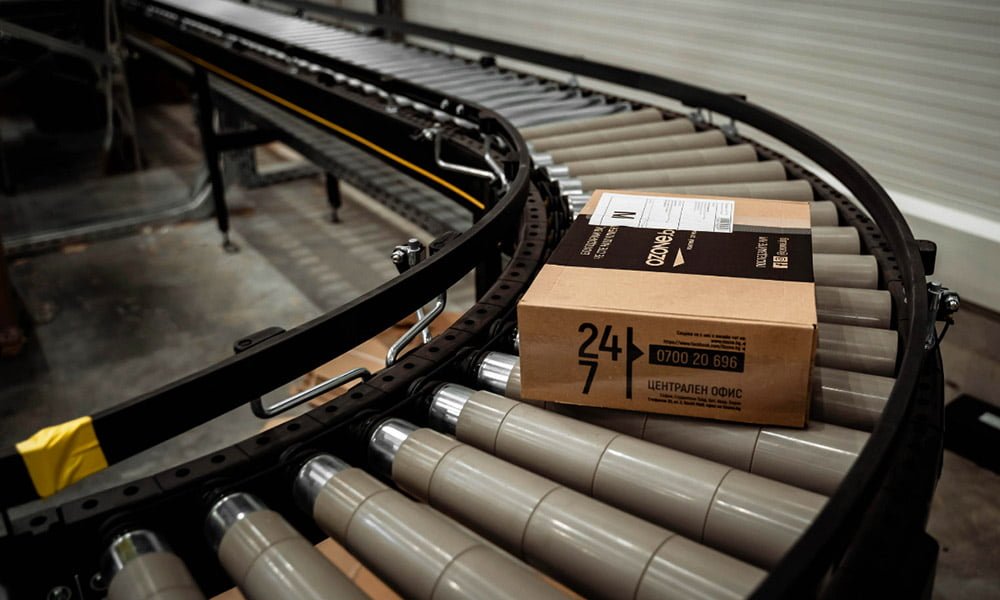Ozone.bg is a leading eCommerce business in Bulgaria, focused on the growing gaming industry, video games, music, movies, technology and IT hardware.
Products of the company can be found in the now typical combination of physical stores in Sofia, Plovdiv, Varna and Burgas, and on a very well developed online, eCommerce platform, reaching the end customer 24/7. This opens the possibility for thousands of online sales and orders to their logistics base, simultaneously.
At the same time, consumer behavior is changing. Custumers are shopping online very often. Phisical stores also need their supplies.
Years ago, Hristo Urumov, owner and manager of STAMH, which specializes in the building of logistics centers, predicted that “for some distribution and logistics hubs, the new situation would be extremely complicated, unless their managers make changes. These centers will start receiving more orders per day than they can physically fulfill”.
Huge increse in the orders volume
With the beginning of the pandemic situation, and not only, the number of orders eCommerce companies in Bulgaria have to prepare is rising. The comparison between the last “normal” week – the one from March 2 to 8 and the one from March 23 to 29, shows a 55% increase in the number of new online end custumer enquieries. And on days like Black Friday, the average value of 1 order reaches BGN 267. The package may include many different items from the storage facility and has to be prepared in minutes.
In fact, this great news for ozone.bg leads to the urgent need to modernize the company’s distribution center, strategically positioned near Sofia.
The new challenge
As a leader in the construction of fast and efficient conveyor systems, the engineering company STAMH meets the new challenge with no fear. Due to the wide variety of items to be picked and collected in separate orders, as well as the fact that sometimes 1 order includes items from different floor levels, the new solution had to speed up all intralogistics processes and connections between different areas.
STAMH’s engineering and software teams focused their efforts on the distribution center, builded on 4000 sq.m., and devided in sever areas:
Areas and systems for the storage of palletized goods;
Space and systems to store small goods (mainly boxes with dimensions of up to 600 mm. / 400 mm. and height up to 600 mm);
- Orders sorting area;
- Packing areas;
- Expedition areas;
An additional challenge for the leader in automated and mechanized storage systems was the distribution of the facilty in 3 different levels above the ground.
All boxes, packages and trays had to run smoothly between zones and to be automatically distributed to the courier company, responsible for the fast delivery. The packaging units that ozone.bg uses are not the same – the boxes are between 250mm / 175mm to 600mm / 400mm, with heights from 10mm. to 600mm. Their weight also varies from 150 gr. to more than 20 kg.
The new solution form the engineering and software proffesionals
To connect the different levels in the distribution center, STAMH builded a gravity roller conveyor structure. The spiral conveyor doesn’t consume energy, which makes it very ecological and economical. At the same time, it saves operators efforts. They no longer have to cover the distances between different floors. The gravity spiral conveyor, connected the second and third storage levels with the packing and sorting areas, located on the base lavel.
Once, the pre-assembled order or package is packed and ready for shipment, it’s placed along a motorized roller conveyor. This conveyor line drives the package to the area, where it’s automatically sorted and leaded to the area of each courier company. Each package can be placed anywhere along the conveyor line for boxes and trays, allowing exceptional flexibility and the definition of different areas, around the conveyor line.
High technology software and hardware solutions
Orders packages travel along the conveyor line, saving efforts and unnecessary distances, normaly covered by operators. They pass through a special camera device with an in-built barcode scanner, funcioning with impressive speed and intensity, able to recognize conventional linear 1D barcodes and 2D – two-dimensional barcodes. 2D barcodes are smaller, but able to “store” much more coded information.
The wide reading area range of the barcode scanner, allowed STAMH Solutions team to cover the ozone.bg sorting neads. Regardless of the size of the box, the special camera is able to capture moving objects within microseconds. So now, the new conveyor line is able to process and sort, thousands of orders in no time.
PLCs are controling all the hardware equipment. They are conected in an highly efficient ethernet network. They send the necessary information to a special HPD sorting conveyor module. This module allows the automatic sorting of baxes between different couriers, resposible for the delivery. This way, the company responsible for the on-time orders delivery of ozone.bg, recieves the package and deliver it to the very impatient end custumer. Much faster.
Fast intralogistics means satisfied customers
As eng. Nadezhda Blagoeva, Technical Director in STAMH says, “The conveyor system connects different areas and speeds up all processes in the logistics base. In a very intuitive way, conveyor lines organize orders preparation processes.
Warehouse operators don’t have to carry heavy trays and packages, covering long distances. They are organized in different areas and manual work is signicantly reduced. Now, thousend of new orders are prepared much faster and in a more efficient way”.
Thanks to STAMH’s engineering and software teams, the distribution center can now meet the increased requirements of the modern market, both by the end customers of ozone.bg and by the physical stores.











